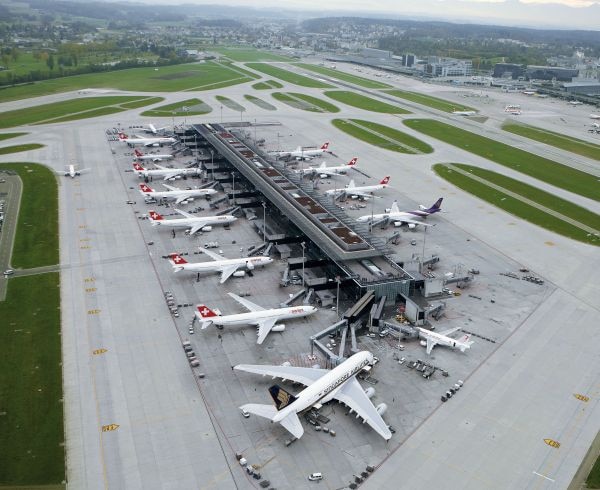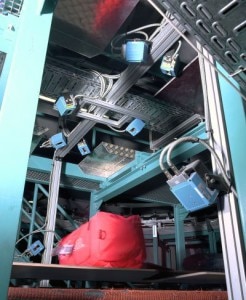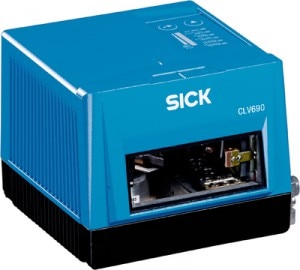More than ten years of positive experiences with the first generation, innovative and future-proof reading technology, as well as outstanding service support - these were the decisive factors that persuaded Flughafen Zürich AG to stick with the ALIS track and trace system from SICK when modernizing their luggage reading gates.  Picture source: Flughafen Zürich AG
Picture source: Flughafen Zürich AG
ALIS (Airport Luggage Identification System) is the most commonly used identification system for luggage at international airports. ALIS systems meet the standards of the International Air Transport Association (IATA) and, depending on the model, can attain reading rates of up to 99 %. They therefore fulfill the requirements for smooth luggage transportation within extensive airport conveyor systems and ensure that cases, bags, and rucksacks can be sorted and directed reliably to the right sorting destination. The ALIS track and trace system achieves reading rates of up to 99 %
The ALIS track and trace system achieves reading rates of up to 99 %
Zurich - An aviation hub of international significance
Taking passenger volumes as a basis, Zurich Airport is one of the most important airports in Europe. In 2013, 24.9 million passengers passed through Zurich Airport, with over 260,000 flight movements to almost 200 international destinations. Over this period, the luggage sorting system (GSA) carried around 10.5 million items of luggage - an average of 29,000 per day.  In order to ensure that luggage does not get lost or end up at the wrong sorting destination, it is extremely important that the IATA luggage tags are identified correctly in the airport's conveying and sorting systems. We have been very happy with the ALIS reading gates that were installed in 2001, confirms Toni Stäuble, head of the GSA Elektro team at Flughafen Zürich AG. However, as it was getting more and more difficult to find spare parts for individual components, and the reading performance requirements were tightening, we felt it was time to replace all of the airport's reading systems to ensure the best possible system throughput and service quality in the long run.
In order to ensure that luggage does not get lost or end up at the wrong sorting destination, it is extremely important that the IATA luggage tags are identified correctly in the airport's conveying and sorting systems. We have been very happy with the ALIS reading gates that were installed in 2001, confirms Toni Stäuble, head of the GSA Elektro team at Flughafen Zürich AG. However, as it was getting more and more difficult to find spare parts for individual components, and the reading performance requirements were tightening, we felt it was time to replace all of the airport's reading systems to ensure the best possible system throughput and service quality in the long run.
The latest technology ensures a decade of reliability
 The CLV690 bar code scanner even reads labels of poor quality reliably
The CLV690 bar code scanner even reads labels of poor quality reliably
The new system technology had to provide state-of-the-art reading gates that could continue, as far as possible, to meet the necessary requirements for years to come, while also ensuring reliable availability of spare parts for at least ten years. It was equally important, however, to improve the reading performance: As the online check-in option is becoming increasingly popular, and this will allow passengers to print their luggage tags at home in the future, we expect to see a partial decrease in the quality of the labels over the next few years as the luggage throughput increases, explains Dieter Bachmann, GSA project manager at Flughafen Zürich AG. This means it is all the more important that the new reading systems can guarantee a very high reading rate, particularly if the label is damaged or the print/contrast quality is poor.
System performance, service, support: The complete SICK package!
 Zurich Airport began by installing reading gates from various suppliers in a test phase to see how feasible these requirements are in practice. We analyzed various factors, including the reading rates achieved, the level of innovation in the proposed solutions, and the promised availability of parts. In the end, it was the excellent product support that we are already familiar with that tipped the scales in favor of SICK and its ALIS technology, recalls Toni Stäuble. And so it proved again: SICK specialists from Waldkirch in Germany and the Swiss subsidiary in Stans showed real dedication to the project during the tendering stage and the subsequent pilot installation of the first ALIS at Zurich Airport. We started by installing a pilot reading gate parallel to the current system, measuring the reading performance in live operation, and optimizing the pilot ALIS until we reached the set targets, confirms Jürg Dönier, maintenance specialist for the GSA Elektro team at Flughafen Zürich AG. They were then able to install all of the other reading gates in several phases in parallel to normal operation, at off-peak times or overnight, and commission them punctually and with the required reading quality. As a result, day-to-day business was barely affected.
Zurich Airport began by installing reading gates from various suppliers in a test phase to see how feasible these requirements are in practice. We analyzed various factors, including the reading rates achieved, the level of innovation in the proposed solutions, and the promised availability of parts. In the end, it was the excellent product support that we are already familiar with that tipped the scales in favor of SICK and its ALIS technology, recalls Toni Stäuble. And so it proved again: SICK specialists from Waldkirch in Germany and the Swiss subsidiary in Stans showed real dedication to the project during the tendering stage and the subsequent pilot installation of the first ALIS at Zurich Airport. We started by installing a pilot reading gate parallel to the current system, measuring the reading performance in live operation, and optimizing the pilot ALIS until we reached the set targets, confirms Jürg Dönier, maintenance specialist for the GSA Elektro team at Flughafen Zürich AG. They were then able to install all of the other reading gates in several phases in parallel to normal operation, at off-peak times or overnight, and commission them punctually and with the required reading quality. As a result, day-to-day business was barely affected.
"ALIS" done the right way
Looking back, everyone involved with ALIS did all of the key things right: Constructing a pilot installation, including intensive collective evaluation of the reading results in live operation over a long period of time, and incorporating the resulting measures for optimization into the other reading gates before installation proved to be a successful method, says Dieter Bachmann, adding: The pragmatic, efficient, target-oriented cooperation with the SICK staff from Waldkirch and Stans and the flexibility that the SICK specialists demonstrated with regard to working hours - which is crucial in the airport business - also proved to be key success factors in the upgrade process for the airport's reading gates.  "ALIS" in sight - the new ALIS generation ensures that all pieces of luggage get to their destination
"ALIS" in sight - the new ALIS generation ensures that all pieces of luggage get to their destination
New reading gates - new records
The figures for Zurich Airport show that the ALIS reading gates will be kept extremely busy, both now and in the future. In the first half of 2014, just under 11.9 million passengers departed from, arrived at, or had a connection at Zurich Airport. Furthermore, the weekend of July 26/27, 2014 saw a new record in Zurich Airport's 66-year history, not once, but twice: Both the Saturday and Sunday broke the record for the largest number of passengers with around 92,000 on each day.
- Product information: ALIS track and trace system, CLV690 bar code scanner
- Product portfolio: Track and trace systems, Bar code scanners
- Customer information: Flughafen Zürich AG

